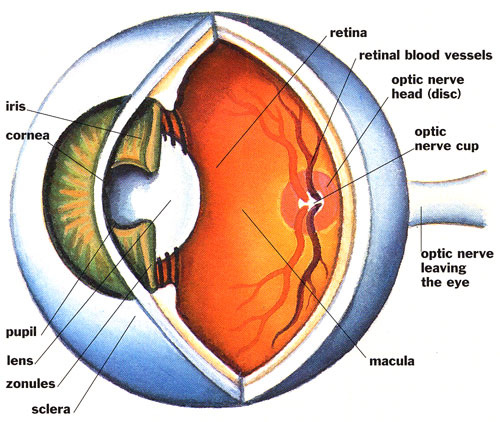Common Eye Conditions
|
Cataracts
http://www.nei.nih.gov/health/cataract/cataract%3Ci%3Efacts.asp - a cloudy area in the normally clear lens of the eye that can interfere with normal vision. Most cataracts are due to age-related changes in the lens and develop slowly in both eyes, but one may be worse than the other. Cataracts may cause blurred or hazy vision, reduced brightness of colors, and increased sensitivity to glare from lights, particularly when driving at night. Treatment includes surgical removal of the cataract lens and replacement with a clear plastic implant lens (intraocular lens). Cataract surgery is one of the safest and most effective types of surgery performed in the United States today. Approximately 90 percent of cataract surgery patients report better vision following the surgery. |
Dry Eye
http://www.nei.nih.gov/health/dryeye/dryeye.asp - a common eye condition resulting from the inadequate wetting of the cornea and conjunctiva. Often, dry eye is part of the natural aging process, but it can also be caused by a blinking or eyelid problems, medications like antihistamines, oral contraceptives and antidepressants, a dry climate, wind and dust, or general health problems like arthritis or Sjogren's syndrome. Symptoms include burning, tearing, itching, soreness, sandy, gritty, tired eyes, foreign body sensation, pain, sensitivity to light and blurring of vision. Treatments include tear suppliments (drops, gels, or ointment), warm compresses and lid scrubs, prescription medications, and punctual plugs.
http://www.nei.nih.gov/health/dryeye/dryeye.asp - a common eye condition resulting from the inadequate wetting of the cornea and conjunctiva. Often, dry eye is part of the natural aging process, but it can also be caused by a blinking or eyelid problems, medications like antihistamines, oral contraceptives and antidepressants, a dry climate, wind and dust, or general health problems like arthritis or Sjogren's syndrome. Symptoms include burning, tearing, itching, soreness, sandy, gritty, tired eyes, foreign body sensation, pain, sensitivity to light and blurring of vision. Treatments include tear suppliments (drops, gels, or ointment), warm compresses and lid scrubs, prescription medications, and punctual plugs.
Glaucoma
http://www.nei.nih.gov/health/glaucoma/glaucomafacts.asp Progressive disease that damages the optic nerve that leads to permanent vision loss. The most common type of glaucoma develops gradually and painlessly, without symptoms. Risk factors include increased age, African American race, and a family history of glaucoma. Glaucoma cannot be prevented, but if diagnosed and treated early, it can be controlled. Treatment for glaucoma involves lowering the eye pressure with the use of eye drops, laser surgery, or filtering surgery.
http://www.nei.nih.gov/health/glaucoma/glaucomafacts.asp Progressive disease that damages the optic nerve that leads to permanent vision loss. The most common type of glaucoma develops gradually and painlessly, without symptoms. Risk factors include increased age, African American race, and a family history of glaucoma. Glaucoma cannot be prevented, but if diagnosed and treated early, it can be controlled. Treatment for glaucoma involves lowering the eye pressure with the use of eye drops, laser surgery, or filtering surgery.
Floaters
http://www.nei.nih.gov/health/floaters/index.asp - Debris found within the vitreous gel that fills the inside of the eye. They appear as spots, cobwebs, or threads that move across your vision as your eyes move. Floaters rarely cause vision problems but they may indicate the start of more serious complications, including retinal holes, tears, or detachment.
http://www.nei.nih.gov/health/floaters/index.asp - Debris found within the vitreous gel that fills the inside of the eye. They appear as spots, cobwebs, or threads that move across your vision as your eyes move. Floaters rarely cause vision problems but they may indicate the start of more serious complications, including retinal holes, tears, or detachment.
Diabetes
www.nei.nih.gov/health/diabetic/retinopathy.asp
Diabetes causes many health problems including diabetic retinopathy, which causes damage to the small blood vessels in the retina. The early stages of diabetic retinopathy may cause blurred vision, blind spots, floaters, or they may produce no visual symptoms at all. If left untreated, diabetic retinopathy can cause blindness, which is one reason why it is important to have your eyes examined regularly by your doctor of optometry. This is especially true if you are a diabetic or if you have a family history of diabetes. Early treatment is important because once damage has occurred, the effects are usually permanent. If you are a diabetic, you can help prevent diabetic retinopathy by taking your prescribed medication as instructed, sticking to your diet, exercising regularly, controlling high blood pressure and avoiding alcohol and smoking.
www.nei.nih.gov/health/diabetic/retinopathy.asp
Diabetes causes many health problems including diabetic retinopathy, which causes damage to the small blood vessels in the retina. The early stages of diabetic retinopathy may cause blurred vision, blind spots, floaters, or they may produce no visual symptoms at all. If left untreated, diabetic retinopathy can cause blindness, which is one reason why it is important to have your eyes examined regularly by your doctor of optometry. This is especially true if you are a diabetic or if you have a family history of diabetes. Early treatment is important because once damage has occurred, the effects are usually permanent. If you are a diabetic, you can help prevent diabetic retinopathy by taking your prescribed medication as instructed, sticking to your diet, exercising regularly, controlling high blood pressure and avoiding alcohol and smoking.
Macular Degeneration
http://www.nei.nih.gov/health/maculardegen/armdfacts.asp - It results from changes to the macula, a portion of the retina that is responsible for clear, sharp vision, and is located at the back of the eye. Most people with macular degeneration have the dry form, for which there is no known treatment. The less common wet form may respond to laser procedures or injected medications if diagnosed and treated early. Some common symptoms are a gradual loss of ability to see objects clearly, distorted vision, a gradual loss of color vision and a dark or empty area appearing in the center of vision. If you experience any of these, contact your doctor of optometry immediately for a comprehensive examination. Central vision that is lost to macular degeneration cannot be restored. However, low vision devices such as telescopic and microscopic lenses can be prescribed to make the most out of remaining vision.
http://www.nei.nih.gov/health/maculardegen/armdfacts.asp - It results from changes to the macula, a portion of the retina that is responsible for clear, sharp vision, and is located at the back of the eye. Most people with macular degeneration have the dry form, for which there is no known treatment. The less common wet form may respond to laser procedures or injected medications if diagnosed and treated early. Some common symptoms are a gradual loss of ability to see objects clearly, distorted vision, a gradual loss of color vision and a dark or empty area appearing in the center of vision. If you experience any of these, contact your doctor of optometry immediately for a comprehensive examination. Central vision that is lost to macular degeneration cannot be restored. However, low vision devices such as telescopic and microscopic lenses can be prescribed to make the most out of remaining vision.
LASIK Surgery
http://www.fda.gov/cdrh/lasik/ - to learn more about LASIK surgery includes an animated video of LASIK procedure.
http://www.fda.gov/cdrh/lasik/ - to learn more about LASIK surgery includes an animated video of LASIK procedure.
Corneal Reshaping or Non-Surgical "Lasik"
http://www.paragoncrt.com/consumers/index.asp
http://www.paragoncrt.com/consumers/index.asp

